Megamouth shark (Megachasma pelagios)
People found out about this extraordinary shark only in 1976 when American soldiers caught one unintentionally. Thus, if it was not for the coincidence, the megamouth shark still could have remained undiscovered.
Although the species was found 40 years ago, it has not been well recognized yet. It is even unknown how big its population is and how it copes with in the world that is overrun by human.
The megamouth shark is the smallest of the three planktivorous sharks: the whale shark and basking shark.
Classification
- Kingdom: Animalia
- Phylum: Chordata
- Class: Chondrichthyes
- Order: Lamniformes
- Family: Megachasmidae
- Genus: Megachasma
- Species: Megamouth shark (Megachasma pelagios)
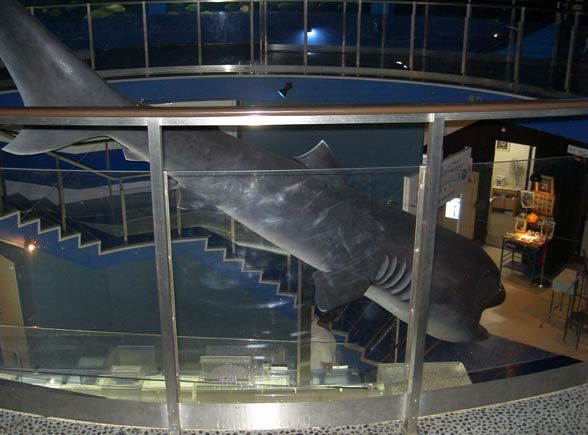
Occurrence
The megamouth shark lives in the Pacific Ocean, the Atlantic Ocean and the Indian Ocean. The most representatives of this extraordinary species have been found in the Pacific Ocean, near the coasts of China, Japan, the Philippines and Taiwan. A large group has also occurred in the East China Sea, the South China Sea, the Sea of Japan, near Sulawesi and the Philippine Trench. It has also been observed near the coasts of Mexico, Ecuador and California. Moreover, it is found along the coasts of:
- Southern Brazil
- Senegal
- Republic of South Africa
- Sri Lanka
- Java
- Sumatra
- South-western Australia

Habitats
It was observed that the megamouth shark prefers deeper waters during the day, and in the night it swims closer to the surface. It is influenced by the movement of small crustaceans, which the shark follows vertically. It was estimated that megamouth sharks could swim at a maximum depth of 1000 meters. Usually, however, this depth does not exceed 160 meters (520 ft) – normally it is 120-160 m (390–520 ft).
The megamouth shark lives in the same habitats that the largest fish in the world – the whale shark (Rhincodon typus). However, it is unknown if it migrates recurrently to feeding grounds. It is suspected that similarly to other large sharks feeding on plankton, the megamouth shark also covers long distances searching for food. It has also been proved by observations of one of individuals discovered in 1990.

Characteristics
Appearance
The body is elongated and sturdy, torpedo-shaped (it narrows towards the rear). The head is flattened and bulbous. The most characteristic feature of the species is very large mouth; it is the mouth that the shark owes its name.
The mouth is filled with around 50 rows of small teeth, but only first three rows are actively used. Males have more teeth than females. Moreover, the teeth are strongly diversified: in the front, straight and sharp teeth grow, they are a bit larger on the sides, and the back teeth are curved towards the rear. Behind them, there are flattened teeth with a large base.
The mouth also holds the big tongue, covered with small but sharp teeth that secrete mucus. Elongated nostrils are situated above the prominent lips. Rounded eyes are situated above them, but more towards the back of the head. Behind the eyes, there are small gill openings. The bottom part of the snout is “armed” with the ampullae of Lorenzini – electroreceptors used for electrolocation, i.e., detecting weak electrical impulses. The sharks can also detect changes in the electrical field, salinity of water and temperature.
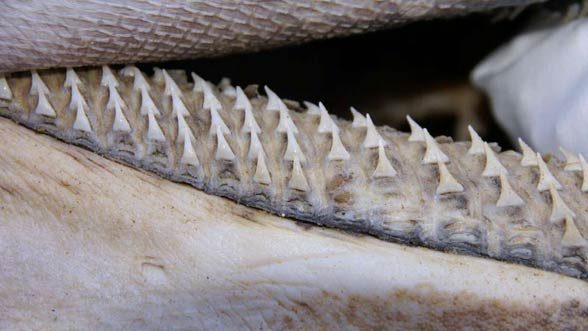
Fins
The first dorsal fin is blunt, low situated, diamond-shaped. The second fin is very similar to the first one, but it is slightly smaller, and its base is wider. The pectoral fins are rounded on the tips, but elongated and wide instead. The abdominal fins, as the dorsal fin, are diamond-shaped. Near the anus, there is a small, triangular and low-situated anal fin. The tail fin is quite big, moreover, it is asymmetrical (the upper part is bigger than the lower one) and vertical.
Scales and coloration
The body of the megamouth shark is covered with shimmering scales whose size and shape change depending on the placement on the body.
They become dark or light gray on the dorsum, they can also be brown, and even dark blue. The sides of the body and the belly are lighter than the dorsum. Usually, they are of shades of white or silver, but sometimes there are individuals whose bottom part of the snout is pink or even red. The sides and the dorsum may also have dark marks.
A white skin band occurs between the upper lip and upper jaw, which becomes visible when the fish protrudes its jaws. It is believed to be a form of lure in deep, dark waters or a method of intra- or inter-species communication.
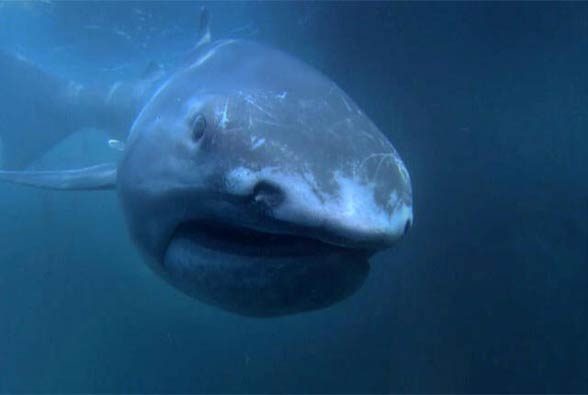
Dimensions
The largest known male was caught in February 1998 near the coast of the Philippines. Its body length was 5.49 m. The largest known female captured near the coast of eastern Japan in 2013 was 5.77 m long.
Diet and hunting
The megamouth shark feeds mostly on krill. It prefers those of the family Euphausiidae the most. However, it can eat small bony fish, copepods and jellyfish.
In the search for food, the megamouth shark swims vertically, according to the movement of krill. To feed, it swims gently into groups of small crustaceans, opening its mouth widely. It pulls its jaws in and out cyclically, at the same time widening its mouth cavity. In this way, it traps its prey in a bubble formed in its mouth. The water from the bubble is pushed out through the gills that filter plankton with special gill rakes. In this way, the food filtered from the water is transported to the stomach.
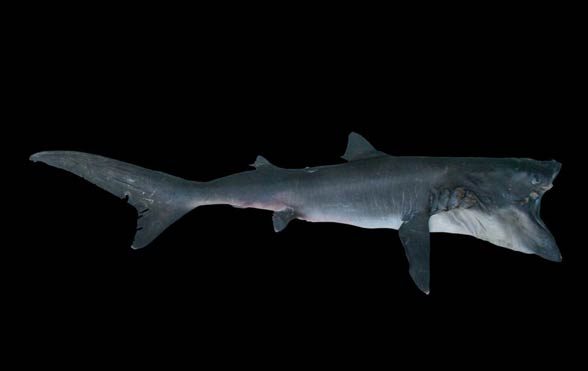
Reproduction
This sphere of the megamouth shark’s life remains a mystery in most part. However, it is known that males have a clasper near the ventral fins – an intromittent organ characteristic for cartilaginous fish.
In females, the vagina that leads to the double uterus is formed where the ventral fins meet.
On the basis of observations of several individuals near the coasts of California, it was found that the breeding period occurs in autumn months. Thorough studies on female megamouth sharks caught near the coasts of Japan have shown, however, that mating may occur at any time in the year. It is also possible that the breeding period depends on the place of occurrence.
It is suspected that megamouth sharks are ovoviviparous. It means that after fertilization, the embryos remain in eggs inside the female’s body. They are born without egg membranes, are fully capable of swimming and obtaining food. Moreover, it was established that males become sexually mature after exceeding 4 meters (13ft 1in) of body length, and females must be at least 5 meters long (16ft 5in). Newborn sharks are about 100 cm (3ft 3in) long.
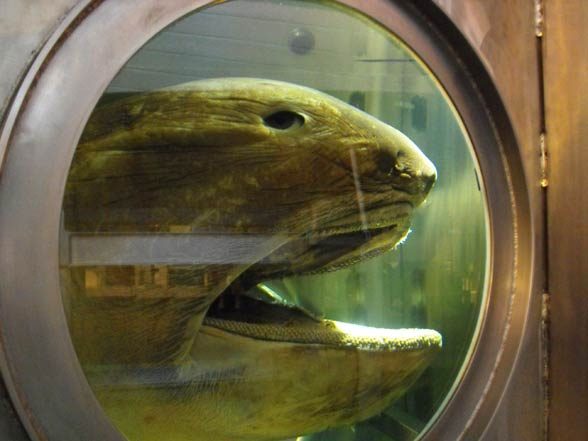
Detailed information / size
Megamouth shark (Megachasma pelagios)
- Body length: males to 5.5 m (18 ft), females to 5.7 m (18ft 8in) – see interesting facts below
- Weight: 600-870 kg (1,323 – 1918lb), but the heaviest known individual weighed 1,215 kg (2,679 lb)
- Mouth width: to 130 cm (4 ft 3 in)
- Typical speed: 1.5–2.1 km/h (0.93–1.3 mph)
Megamouth shark – interesting facts
- The generic name Megachasma comes from Greek words mega “large” and chasma “opened mouth”. The Greek term pelagios means “coming from the open sea”.
- A megamouth shark was caught for the first time on 15 November 1976. It was accomplished by the United States Navy near Hawaii. The individual was 4.5 m (14.7-ft) long and weighed 750 kg (1,650 lb). The catch, however, was not planned – the shark enmeshed in the anchor line.
- According to a few reports, there are individuals that are longer than 6 m (19ft 8in), and can reach even 7 m (22ft 12in). However, this information has not been confirmed.
- Cannibalism may occur in the uterus of a female megamouth shark. The young eat each other, therefore, only the strongest individuals are born. It is also possible that the phenomenon of oophagy occurs in the womb – the first hatched shark eats the rest of unhatched siblings.
- Only 63 individuals were observed to 2014. Most of them were dead, some of them enmeshed in various nets, and only four of them were released back to the sea alive. Some sharks were given to museums for research purposes, and others were sold for consumption purposes.

Recommended
- Marine
- Sharks – myths and facts
- Sharks – killers from the depths
- Great white shark
- Megalodon
- Whale shark – largest fish
- Basking shark – the second largest fish
- Greenland shark
- Hammerhead shark
- Tiger shark
- Longest whales
- Heaviest whales
- Largest sharks
- Extinct animals
- Animal fights
- American lion
- European cave lion
- Smilodon – Saber-toothed tiger
- Fastest animals
- Fastest birds

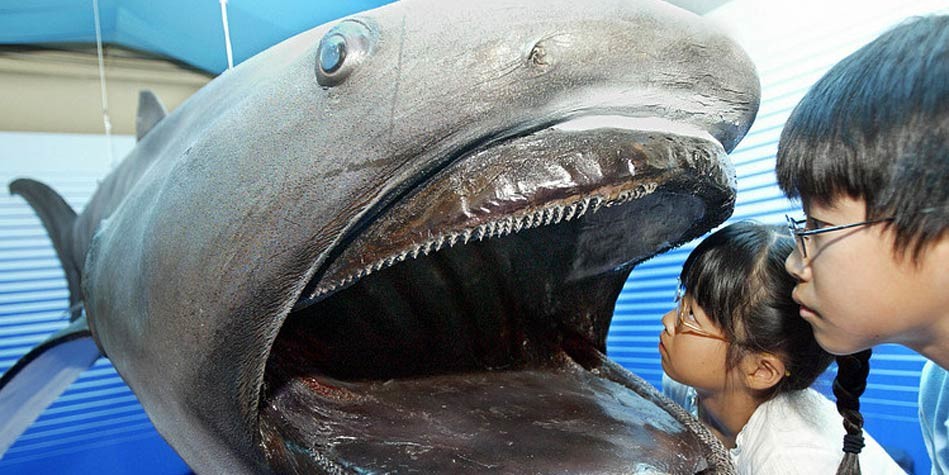








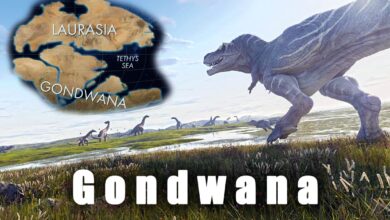


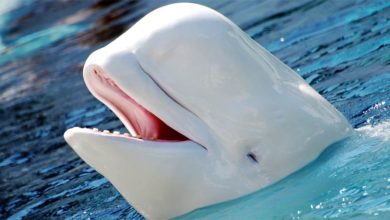
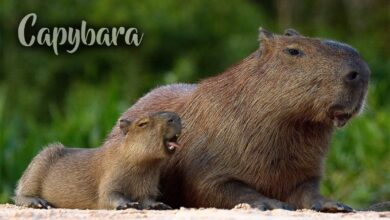


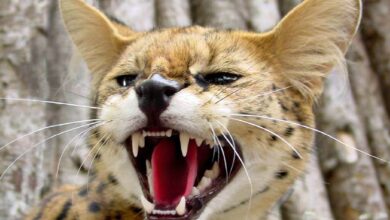

Merry Christmas DinoAnimals!
Merry Christmas and Happy New Year to all our readers!